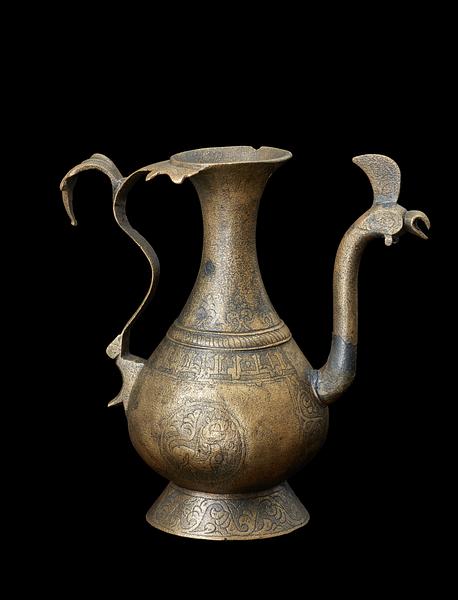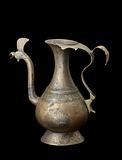Ewer, cast and engraved bronze
Spain, Andalusia; late 10th-early 11th century
H: 22 cm
This ewer from al-Andalus, made at around the time of the fall of the Umayyad Caliphate, has a more elegant form than most contemporary ewers from the Islamic world.
The inscription al-mulk l-Illah (royal power is God’s) is often found in the art of the period in Spain. So are the palmette bands and the engraved lion in an embossed medallion. Three Spanish ewers of this type have been published; one of them is missing its spout and the second has a lion’s head.
The museum’s is the only one that allows the beholder to enjoy the interplay between the handle’s tail-like palmette and the spout’s slightly aggressive cock or peacock head. The ewer was found in the sea, which explains its pitted surface.
Inv. no. 5/1990
Published in:
Sotheby’s, London, 25/4-1990, lot 104;
Jerrilynn D. Dodds (ed.): Al-Andalus: the art of Islamic Spain, Metropolitan Museum of Art, New York 1992, cat.no. 14;
Kjeld von Folsach, Torben Lundbæk and Peder Mortensen (eds.): Sultan, Shah and Great Mughal: the history and culture of the Islamic world, The National Museum, Copenhagen 1996, cat.no. 195;
Éric Delpont (ed.): Les Andalousies de Damas à Cordoue, Institut du monde arabe, Paris 2000, cat.no. 168;
Richard Ettinghausen, Oleg Grabar, Marilyn Jenkins-Madina: Islamic art and architecture 650-1250, 2. ed., New Haven 2001, p. 98, fig. 151;
Kjeld von Folsach: Art from the World of Islam in The David Collection, Copenhagen 2001, cat.no. 457;
Joachim Meyer and Peter Northover: “A newly acquired Islamic lion door knocker in the David Collection” in Journal of the David Collection, 1, 2003, p. 59, fig. 13;
Assadullah Souren Melikian-Chirvani (ed.): The world of the Fatimids, Aga Khan Museum, Toronto [2018], pp. 302-303 and pp. 351-352;
Rafael Azuar Ruiz: Las taifas del Sharq al-Andalus en las rutas y el mercado mediterraneo del siglo XI, [Valencia] 2019, pp. 153-154;
Claudia Höhl, Felix Prinz and Pavla Ralcheva (eds.): Islam in Europa: 1000–1250, Dommuseum Hildesheim, Regensburg 2022, cat.no. 74;


